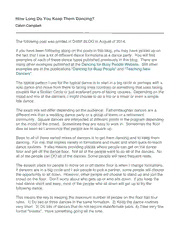
How Long To Keep Them Dancing PDF
Preview How Long To Keep Them Dancing
How Long Do You Keep Them Dancing? Calvin Campbell The following post was printed in D4BP BLOG in August of 2014. If you have been following along on the posts in this blog, you may have picked up on the fact that I use a lot of different dance formations at a dance party. You will find examples of each of these dance types published previously in this blog. There are many other examples published at the Dancing for Busy People Website. Still other examples are in the publications “Dancing for Busy People” and “Teaching New Dancers”. The typical pattern I use for the typical dance is to start in a big circle or perhaps with a solo dance and move from there to facing lines (contras) or something that uses facing couples like a Sicilian Circle or just scattered pairs of facing couples. Depending on the mood and mix of the dancers, I might choose to do a trio or a mixer or even a simple folk dance. The exact mix will differ depending on the audience. Father/daughter dances are a different mix than a wedding dance party or a group of teens or a retirement community. Square dances are interjected at different points in the program depending on the mood of the crowd. Sometimes they are easy to work in. Sometimes the floor dies as soon as I announce that people are to square up. Basic to all of these varied mixes of dancers is to get them dancing and to keep them dancing. For me, that implies variety in formations and music and short quick-to-teach dance routines. It also means providing places where people can get on the dance floor and get off the dance floor. Not all of the people want to do all of the dances. No all of the people can DO all of the dances. Some people will need frequent rests. The easiest place for people to move on or off dance floor is when I change formations. If dancers are in a big circle and I ask people to pick a partner, some people will choose the opportunity to sit down. However, other people will choose to stand up and join the crowd on the floor. Don’t worry about who gets up or who sits down. If you keep the next dance short and easy, most of the people who sit down will get up to try the following dance. This means the key to keeping the maximum number of people on the floor has four rules. 1) Do two or three dances in the same formation. 2) Keep the dance routines very short. 3) Do lots of dances that do not require male/female pairs. 4) Take very few formal “breaks”. Have something going all the time. If you faithfully do all of the above, you will find that more people will be willing to get up and dance. Why? Because they know they will only be on the dance floor for as long as “they” want to be on the dance floor. For some people that will be every dance of the evening. Some people will choose to sit out half or more of the dances. Most of the gigs I do are 90 minutes long. Sometimes they are two hours long. For a 90 minute dance, I schedule a five minute formal break about half way through the dance. At the end of the five minutes, I put on two solo/line dances to get people back onto the floor. On a two hour gig, I schedule a five minute break at 45 minutes and another break about 30 minutes later. After any break, doing a dance that does not require partners is critical. It can be a solo dance, or a big circle, a conga line, or something else. The big thing is that it must be the type of dance where people can walk on to the floor and quickly get into the action. The amount of time it takes to teach a square dance routine or a “basic” can be a “crowd killer”. You are far better to teach something simple than to take too much time tying to explain how to do a dance routine or a square dance “basic”. Square dances are particularly bad for taking too much time to teach. They require the cooperation of eight people and sometimes all eight people don’t get what you are trying to teach them how to do. So! If you decide to teach a certain square dance “basic”, try to teach the “basic” as part of some other dance formation and then reteach it in the square formation. It will avoid a lot of problems. The bottom line is that people came to dance, not take lessons. Keep it Simple, Keep it Fun.
